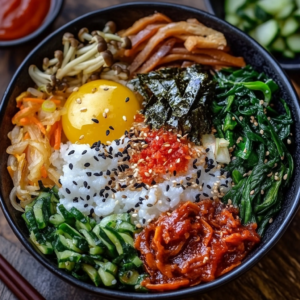Bibimbap (비빔밥): A Colorful and Flavorful Korean Classic
Bibimbap (비빔밥) is one of Korea’s most beloved and visually stunning dishes, offering a harmonious mix of flavors, textures, and vibrant colors. The word “bibimbap” literally means “mixed rice,” and it consists of a warm bowl of rice topped with an array of sautéed vegetables, seasoned meat, a fried egg, and spicy gochujang sauce. Not only is it delicious and satisfying, but it’s also a nutritious, balanced meal that can be customized to suit your preferences. Whether you’re a fan of bold, spicy flavors or looking for a wholesome, healthy dish, bibimbap is a perfect choice that brings the best of Korean cuisine to your table.
Why You’ll Love Bibimbap
Vibrant and Nutritious: Each bowl of bibimbap is a feast for the eyes and body, featuring a rainbow of vegetables, protein, and healthy fats from the egg and sesame oil.
Customizable: Bibimbap is highly versatile—you can swap the protein with tofu for a vegetarian option, add extra veggies, or adjust the spice level to suit your taste.
Easy to Prepare: While bibimbap may look complex, it’s surprisingly simple to make. Most ingredients can be sautéed in just a few minutes, and you can prepare the components ahead of time for easy assembly.
Balanced and Satisfying: With a mix of carbs, protein, and veggies, bibimbap is a complete meal that’s not only flavorful but also filling and balanced.
How to Enjoy Bibimbap
Assemble the Bowl: Layer your cooked rice with seasoned vegetables, savory meat, and a perfectly fried egg.
Add the Gochujang: Drizzle the bowl with a tangy-spicy gochujang sauce to bring all the flavors together.
Mix and Enjoy: Stir everything together to create a deliciously satisfying mix of flavors and textures.
Whether you’re new to Korean cuisine or already a fan of its bold flavors, Bibimbap is a must-try dish that’s both delicious and nutritious. Its vibrant presentation and rich flavor profile make it a perfect meal for any occasion—give it a try and enjoy the magic of mixing it all together!
Bibimbap (비빔밥)
Ingredients:
For the Bibimbap:
2 cups cooked short-grain white rice (or brown rice)
1/2 pound ground beef (or chicken, tofu, or pork)
1 tablespoon soy sauce
1 teaspoon sesame oil
1 teaspoon sugar
1 clove garlic, minced
1 tablespoon vegetable oil
1 medium carrot, julienned
1 zucchini, sliced into thin matchsticks
1 cup spinach or other leafy greens, blanched
1 cup bean sprouts, blanched
4 shiitake mushrooms, sliced
4 eggs (fried, poached, or raw depending on preference)
1/2 cucumber, thinly sliced
Sesame seeds (for garnish)
Kimchi (optional)
For the Gochujang Sauce:
2 tablespoons gochujang (Korean red chili paste)
1 tablespoon sesame oil
1 tablespoon rice vinegar
1 tablespoon sugar or honey
1 teaspoon soy sauce
Instructions:
Prepare the Rice:
Cook 2 cups of short-grain white rice (or brown rice) according to package instructions. Set aside and keep warm.
Cook the Meat:
In a small bowl, combine the ground beef (or chosen protein) with soy sauce, sesame oil, sugar, and minced garlic. Mix well.
Heat 1 tablespoon of vegetable oil in a skillet over medium heat. Add the marinated meat and cook for 4-5 minutes, breaking it up as it cooks, until browned and cooked through. Set aside.
Sauté the Vegetables:
In the same skillet, add a little more oil if needed. Sauté the carrots, zucchini, shiitake mushrooms, and spinach (separately) for 2-3 minutes each, seasoning lightly with salt. Blanch the bean sprouts for 1-2 minutes in boiling water and drain.
Set each vegetable aside in separate bowls to keep them distinct for presentation.
Fry the Eggs:
In a separate pan, fry eggs sunny-side-up, leaving the yolks slightly runny. If preferred, poach or use raw eggs (a common choice in Korea).
Make the Gochujang Sauce:
In a small bowl, whisk together the gochujang, sesame oil, rice vinegar, sugar, and soy sauce until well combined. Set aside for serving.
Assemble the Bibimbap:
In each bowl, place a serving of rice at the bottom. Neatly arrange the cooked vegetables, meat, and cucumber slices on top of the rice.
Add a fried egg in the center of the bowl, sprinkle with sesame seeds, and top with a spoonful of the gochujang sauce.
Serve:
Serve the bibimbap with kimchi on the side (optional) and extra gochujang sauce for those who prefer more heat.
To eat, mix everything together in the bowl, breaking the yolk, and enjoy!
Optional Add-ins:
Vegetarian Option: Use tofu or tempeh in place of the meat for a vegetarian version of bibimbap.
Spice Level: Adjust the amount of gochujang in the sauce based on your preferred spice level.
Crunch Factor: Add a layer of crispy rice by pressing the rice down in a hot pan until it forms a golden crust before adding the toppings.
Tips:
Use Leftovers: Bibimbap is a great dish to use up leftover vegetables or proteins, as long as you have rice and gochujang sauce, you can mix and match the toppings.
Healthy Twist: Add other veggies like bell peppers, edamame, or kale to increase the nutritional value of the dish.
This Bibimbap recipe is a delightful mix of flavors, textures, and colors, making it one of the most satisfying and versatile Korean meals. Enjoy!


